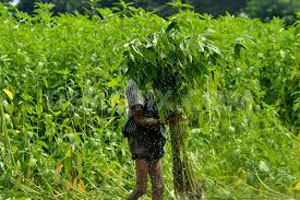
Barisal jute farmers aspire to hike market price by their profuse cultivation
YarnsandFibers News Bureau 2014-07-20 17:30:00 – BangladeshWith the cultivation of jute on 1, 94,880 hectares of land, it seems that jute farmers of Barisal would get good returns of their agricultural product. The farmers have approached the government for co-operation to check the flow of low quality seeds during the sowing season and expansion of national and international market.
Farmers are cultivating the cash crop in larger areas of land as it is earning them good profit for the last four years approaching environment-friendly use of jute-fiber produced items was the statement of Mojibul Haque Mia, additional director, department of agricultural extension in Barisal region.
Under this cultivation, ‘Deshi (indigenous) variety of jute cultivated in 4,081 hectares, ‘Tosha’ in 1,77,263 hectares, ‘Mesta’ in 9,796 hectares, ‘Kenaf’ in 3,740 hectares of lands in the region, told the additional director of AED.
After ending of cultivation, it may exceed the target to 2, 01,165 hectares of land with a targeted production of an average of 11 bell per hectare ( 1 bell=5 maunds) for producing 22,12,815 bells of jute fibres, said Rafiqul Islam, deputy director AED Barisal regional office.
Barisal AED sources said this year farmers of 11 districts including Barisal, Patuakhali, Jhalakati, Pirojpur, Bhola, Barguna, Faridpur, Rajbari, Shariatpur, Madaripur and Gopalganj under Barisal agricultural region cultivated mainly ‘tosha’ (chorchorous olitorius) varieties of jute.
Besides, farmers have also cultivated fabric varieties of Deshi, Mechhta and Kenaf jutes on few hectares of land in different parts of Barisal agricultural region.This cultivated jute will be used as vegetables in limited range in Bhola, Patuakhali and Barguna districts.
Already harvesting of more than 60 percent of Tosha varieties has been completed in the region. Field level agricultural staffs and farmers said growers had to spend about Tk 12-15,000 for jute cultivation on a bigha of land that may produce 10 to 14 maunds jute fibres in this season worth Tk 25,000-30,000.
According to jute farmers, the product, although delayed because of late raining in the region, but August-September will be the peak season for harvesting. The price of the jute sticks (patkhori), also usable as fence and fuel, hoped to be higher than the previous year.
They need centres of Jute Research Institute for field level training about developed and modern cultivation methods of jute and ensure sufficient supply of standard jute seeds in fair price, said Rashid Mia, a jute farmer of Agoiljhara at Barisal-Gopalganj district border.
Although the jute farmers alleged about facing seed crisis hampering sowing in time and forcing them to collect low quality seeds from market at higher prices; office assistant of the seed section of Bangladesh Agricultural Development Corporation, Shafiur Rahman, denies the allegation saying that they supplied sufficient quality seeds to fulfill the demands of the farmers.
But even after many intricacies faced by the golden fibre jute farmers in 11 districts of Barisal agricultural region , they keep bright hopes as market price burgeons owing to copious cultivation.
Market Intelligence
Ask for free sample Report

experience
Customer Base
dedicated team
Countries Served Worldwide









